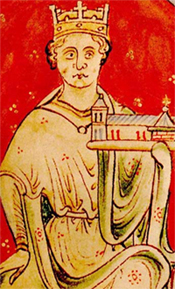King John - Part 3
Early years through to 1199
As the 5th and final son John could not have expected an inheritance. Believed to be the favourite son of his father, his early years must have been tumultuous indeed. When his father tried to advance his political career sending him to Ireland, the result was such a catastrophe that he had to return after 6 months. There were many examples of subterfuge and plotting particularly when Richard was away on the 3rd Crusade.
 On the death of his brother Richard at Château de Chalus-Chabrol, France in 1199 Johnentered the second phase of his life. After suppressing rival claimants to the throne, notably Arthur Duke of Brittany, John had to deal with Philip Augustus, or Philip II and his growing plans for a French country. This came through the Treaty of Le Goulet signed in May 1200. This recognised John as a vassal of Philip and for the first time the true power of the nascent French state began to grow and the English grip on their French possessions started to wane. From this came his nickname of John Softsword.
On the death of his brother Richard at Château de Chalus-Chabrol, France in 1199 Johnentered the second phase of his life. After suppressing rival claimants to the throne, notably Arthur Duke of Brittany, John had to deal with Philip Augustus, or Philip II and his growing plans for a French country. This came through the Treaty of Le Goulet signed in May 1200. This recognised John as a vassal of Philip and for the first time the true power of the nascent French state began to grow and the English grip on their French possessions started to wane. From this came his nickname of John Softsword.
The Loss Of Normandy
It is important to understand the historical ties here. When William the Conqueror arrived in England in 1066 he kept his grip on Normandy. The new English nobles also held lands and power in Normandy. It was not that the English owned Normandy but more the other way round.
The French lands to the South and West, Aquitaine, came through the marriage of Eleanor to Henry II. The barons of these French lands all had their own agendas and had to be kept in control. Into this came Philip Augustus with his plans to grow the French state. Seasoned with years of fighting or plotting against Henry II and Richard he was too wily and strong for John. The conclusive action did not take place until 1214 when the French overcame John and his coalition forces at the Battle of Bouvines on 27 July. Aquitaine remained tied to the English crown until the end of the Hundred Years War in 1453. Above right: Portrait of King John of England (John Lackland from Historia Anglorum 1250-59)
Relations With The Catholic Church
Although John was an atheist he recognised the power of the Holy Church and sought to use it whenever he could. We tend to think of the main disputes with the church as having to do with either money or the annulment of a marriage. This was not the case here and in some ways it is so typical of John that so damaging a disagreement could come from a small problem. When Hubert Walter, the Archbishop of Canterbury died on 13 July 1205, John sought to replace him with his own man. The Pope, Innocent III, refused and the situation escalated to the point where the Pope placed an interdict on the Kingdom in March 1208. This withheld many of the Church's dispensations from the common people. Although no rioting resulted it must have placed a huge strain on John's subjects.
John surrendered to the Pope in 1213. - King John Part 4 - King John Part 2


